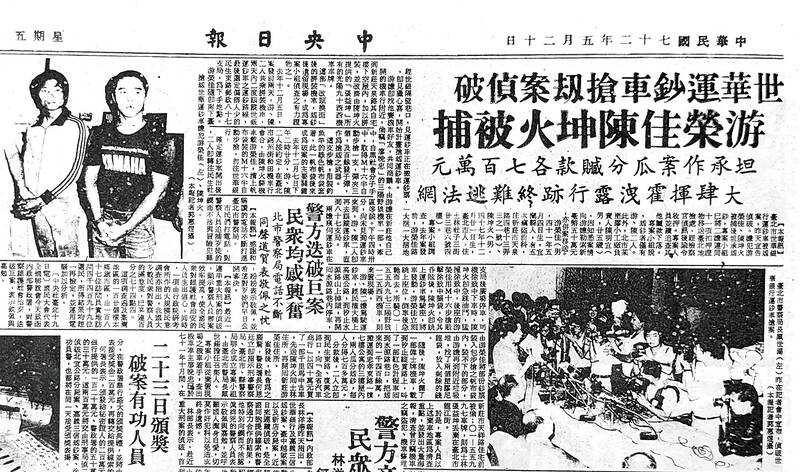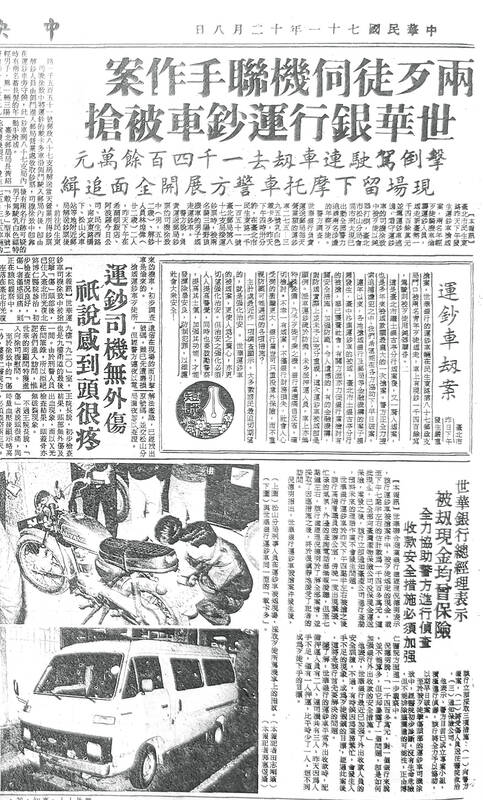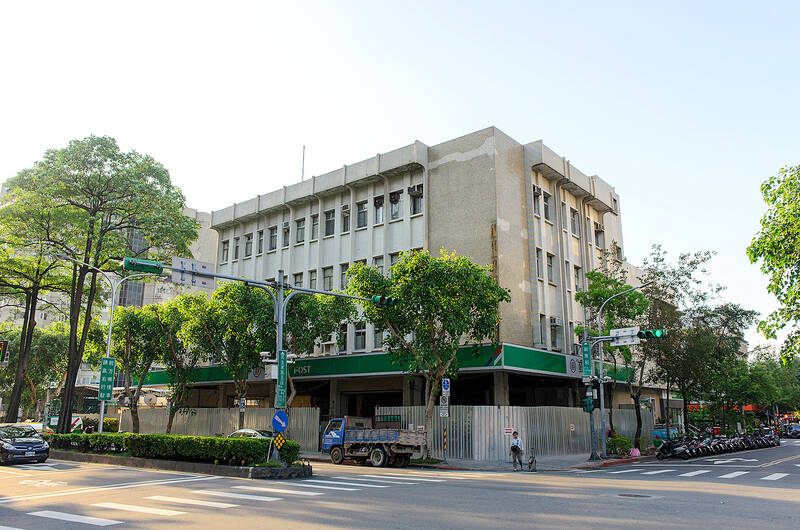Dec 2 to Dec 8
It was the biggest heist in Taiwanese history at that time.
In the afternoon of Dec. 7, 1982, two masked men armed with M16 assault rifles knocked out the driver of a United World Chinese Commercial Bank (世華銀行) security van, making away with NT$14 million (worth about NT$30 million today). The van had been parked behind a post office at Taipei’s Minsheng E Road when the robbers struck, and despite the post office being full of customers, nobody inside had noticed the brazen theft.

Photo courtesy of National Central Library
“Criminals robbing a bank truck is something we only see in American Westerns, but yesterday this scene happened on the streets of Taipei,” a United Daily News editorial stated. “In Taiwan, previously a place of law and order, people are now robbing banks, bank trucks and post offices. This is a serious problem that goes beyond whether the police can solve these cases or not.”
Eight months earlier, Taiwan witnessed its first armed bank robbery when Lee Shih-ke (李師科) made off with about NT$5.3 million from the Land Bank of Taiwan’s Guting branch (see “Taiwan in Time: The robber in the sanitary mask,” April 9, 2017). And on the same day as the robbery, gunmen barged into the Chiayi District Court in broad daylight and broke out a detainee.
“There are two reasons for this flurry of crimes: the slumping economy and the societal trend toward extravagance; the pursuit of material pleasures is in vogue,” the editorial said.

Photo courtesy of National Central Library
The police apprehended the culprits 163 days later, discovering that it was connected to another robbery committed the previous year in Taichung’s Shalu District (沙鹿). The eight men involved in both cases were executed on July 29, 1983.
FIRST HEIST
Taiwan Cooperative Bank’s Shalu branch usually transported cash in their own truck. But the vehicle was not available on Nov. 24, 1981 when they needed to move NT$6.8 million to another location, and they called a reputable local taxi service to do the job.

Photo courtesy of Wikimedia Commons
According to the Office of Historical Suspense Investigation and Research (重大歷史懸疑案件調查辦公室), this was not uncommon in those days as bank security was generally lax. After all, violent crimes such as robbery, kidnapping and rape were punished by death under martial law.
The taxi was halfway to its destination when a light blue sedan, which had been tailing it, suddenly blocked its way. Four men armed with knives leapt out, threatened the driver, snatched the car keys, forced the passengers from the car and then drove the taxi away. The whole ordeal took five minutes.
The subsequent investigation led police to Su Chun-mo (蘇俊模), who belonged to an influential local family, and arrested him along with five other suspects 25 days after the crime. Su admitted that he had large gambling debts and had been planning the heist for about a year. They were all sentenced to death by a military court.

Photo courtesy of Wikimedia Commons
Such crimes were unprecedented in Taiwan; so when the United World Chinese Commercial Bank truck was carjacked just over a year later, the police were greatly alarmed. Was this a copycat, or were the two cases connected?
COLD CASE
The second heist proved harder to solve, as Taipei was much larger than Shalu and CCTV cameras were not common then. The United Daily News reported that the cops suspected it to be an inside job, as the bank’s cash transportation schedule and route was known only by upper management. The robbers even knew when post office guards got off work and chose the exact right time to strike.
The truck was meant to pick up cash from eight stops and then return to the bank; the post office was its sixth stop. The driver, who was not supposed to leave the vehicle, was standing next to it waiting for his colleague to retrieve money from the post office when he was struck in the back of the neck with a long object in a canvas bag. In his dazed state, he vaguely saw the two men take out an assault rifle from the bag, yelling at the few people who were on scene to freeze before speeding away. A few postal workers gave chase, but lost sight of the vehicle.
The police only had one clue: a scooter. However, it turned out to be stolen and the serial number had been removed. No fingerprints could be found on the vehicle, leading police to conclude that it had been a carefully planned job.
Meanwhile, Su and his cohorts were living it up in prison because his family bribed the staff. He even paid a doctor to sign him out of the hospital to seek treatment for acute otitis, using the clinic for trysts with his girlfriend. Still, death was near.
In early 1983, Su smuggled a saw into his cell, patiently worked on the bars bit by bit, and in April escaped with five other inmates. They managed to acquire an M16 rifle while on the run, but they were found by police seven days later and sent back to jail after a brief gunfight.
MATCHING RIFLES
The involvement of an M16 in both incidents further convinced the police that they were related. After searching Su’s hiding place, they found a canvas bag that matched a description of the one the United World Chinese Commercial Bank robbers used to conceal the M16.
After questioning the Shalu incident detainees and information from secret witnesses, they directed their attention toward Yu Jung-chia (游榮佳), who was Su’s uncle.
They soon discovered that Yu, who had a lengthy criminal record, had been spending lavishly. His home address was also very close to the place where the scooter was stolen. Finally, one of Su’s cohorts broke under pressure and told the cops about Yu’s involvement. Yu and another alleged accomplice, Chen Kun-huo (陳坤火), were arrested in May 1983 and after intense questioning, both admitted to the crime.
Yu later told reporters that part of his motive was to provide for Su’s legal fees and escape, since the Su family had already spent a great deal of money on the case. Su had helped out Yu financially in the past, and felt obligated to return the favor.
He claimed to have given the Su family a total of NT$4 million, with NT$500,000 going directly to Su after he escaped from jail. As for Chen, he said he needed money for his upcoming wedding. According to Yu, the M16 was provided by a relative of Su, and after the heist they returned it to the family, who gave it to Su once he escaped.
All eight robbers faced the firing squad on the same day. Yu seemed the most repentant, according to the United Daily News, as he left behind a wife and a one-year-old child. In his last words, he told his friends to care for his family and urged his wife to teach his son well, so that he would not follow the same path.
Taiwan in Time, a column about Taiwan’s history that is published every Sunday, spotlights important or interesting events around the nation that either have anniversaries this week or are tied to current events.

On April 26, The Lancet published a letter from two doctors at Taichung-based China Medical University Hospital (CMUH) warning that “Taiwan’s Health Care System is on the Brink of Collapse.” The authors said that “Years of policy inaction and mismanagement of resources have led to the National Health Insurance system operating under unsustainable conditions.” The pushback was immediate. Errors in the paper were quickly identified and publicized, to discredit the authors (the hospital apologized). CNA reported that CMUH said the letter described Taiwan in 2021 as having 62 nurses per 10,000 people, when the correct number was 78 nurses per 10,000

As we live longer, our risk of cognitive impairment is increasing. How can we delay the onset of symptoms? Do we have to give up every indulgence or can small changes make a difference? We asked neurologists for tips on how to keep our brains healthy for life. TAKE CARE OF YOUR HEALTH “All of the sensible things that apply to bodily health apply to brain health,” says Suzanne O’Sullivan, a consultant in neurology at the National Hospital for Neurology and Neurosurgery in London, and the author of The Age of Diagnosis. “When you’re 20, you can get away with absolute

May 5 to May 11 What started out as friction between Taiwanese students at Taichung First High School and a Japanese head cook escalated dramatically over the first two weeks of May 1927. It began on April 30 when the cook’s wife knew that lotus starch used in that night’s dinner had rat feces in it, but failed to inform staff until the meal was already prepared. The students believed that her silence was intentional, and filed a complaint. The school’s Japanese administrators sided with the cook’s family, dismissing the students as troublemakers and clamping down on their freedoms — with

As Donald Trump’s executive order in March led to the shuttering of Voice of America (VOA) — the global broadcaster whose roots date back to the fight against Nazi propaganda — he quickly attracted support from figures not used to aligning themselves with any US administration. Trump had ordered the US Agency for Global Media, the federal agency that funds VOA and other groups promoting independent journalism overseas, to be “eliminated to the maximum extent consistent with applicable law.” The decision suddenly halted programming in 49 languages to more than 425 million people. In Moscow, Margarita Simonyan, the hardline editor-in-chief of the